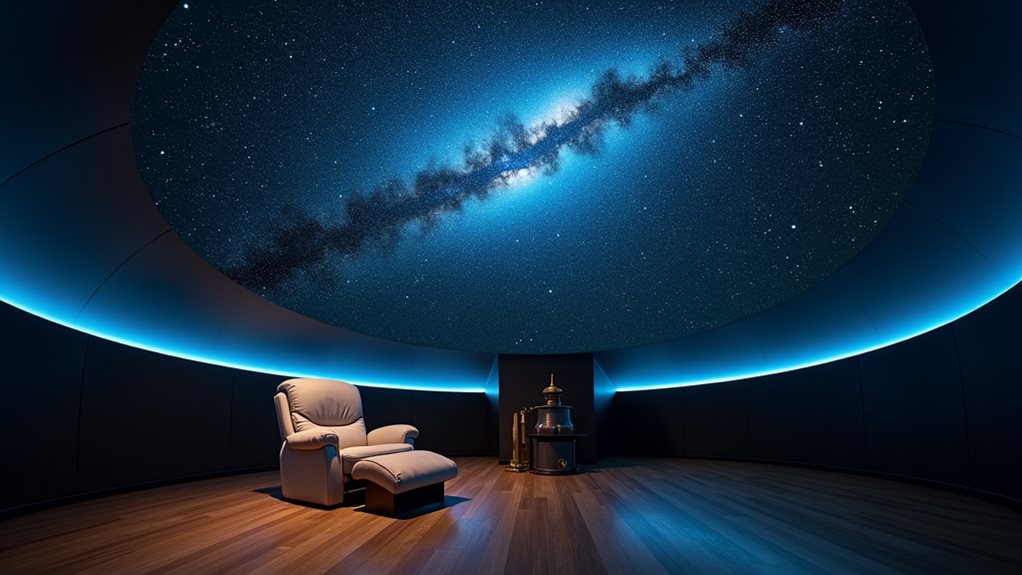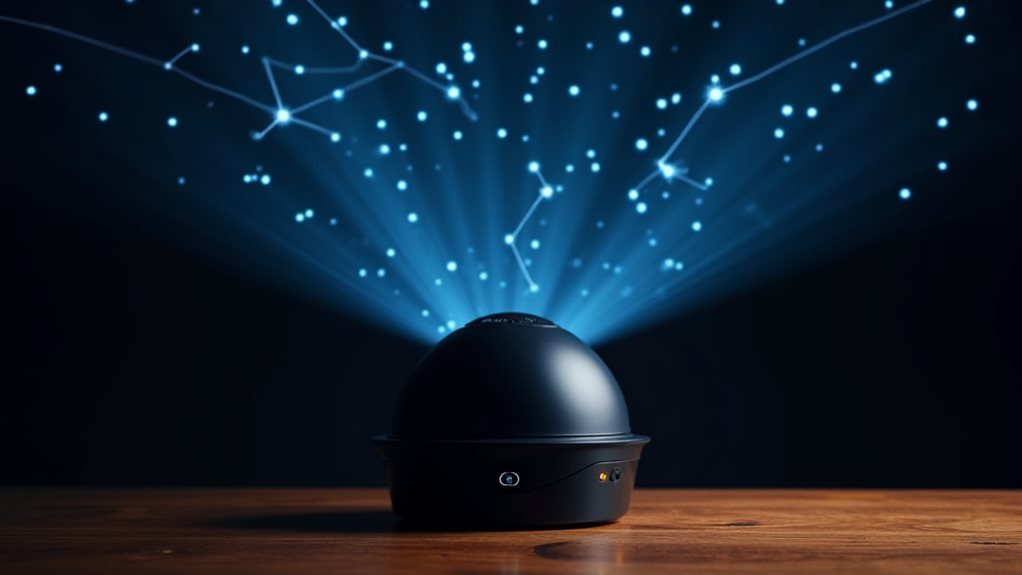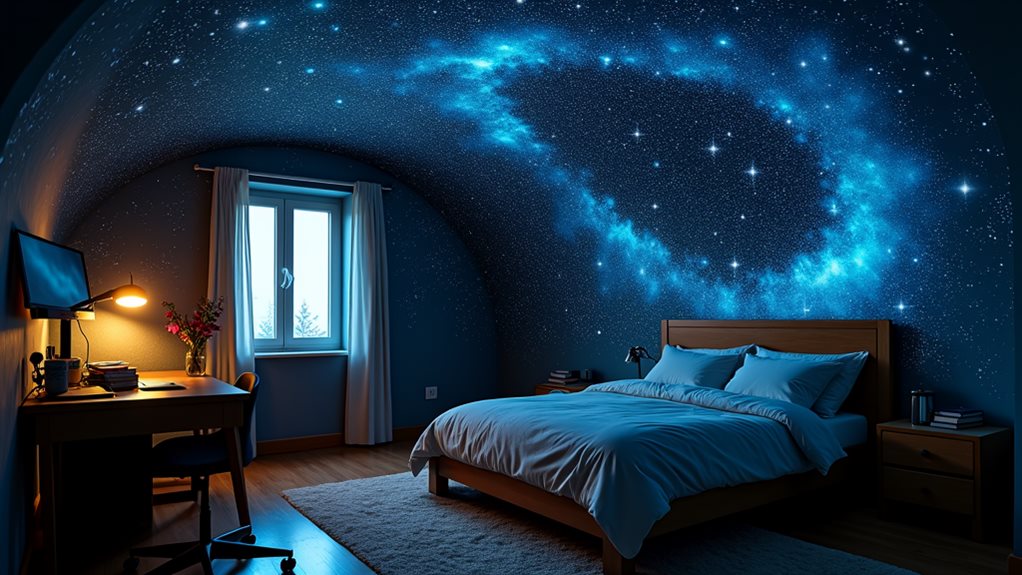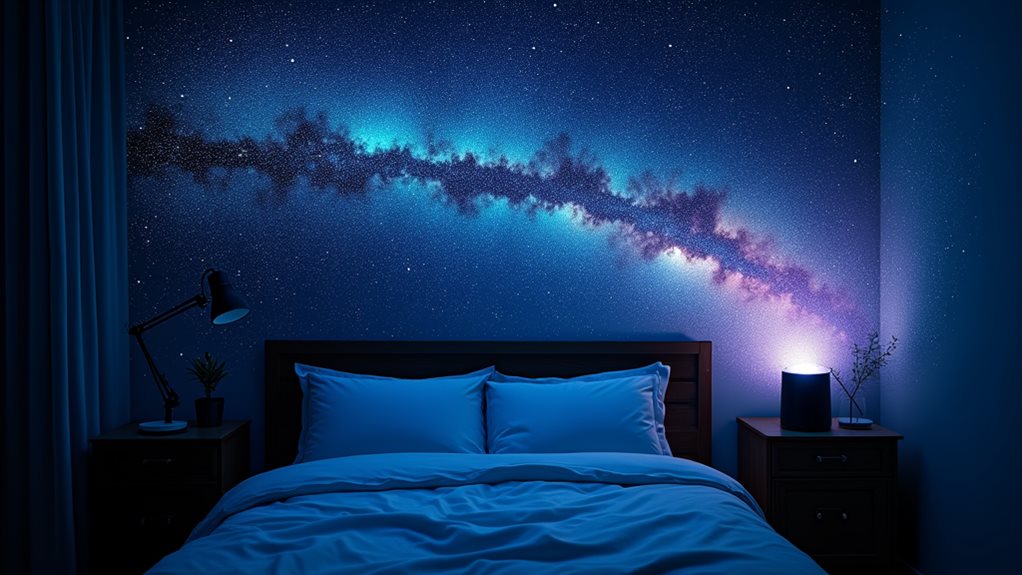Home planetariums transform your living space into a personal observatory through advanced LED technology and digital innovations. You’ll experience crystal-clear projections of up to 60,000 stars, with customizable star maps and integrated sound features for an immersive celestial journey. Modern systems offer smartphone integration, voice control, and educational content to enhance your cosmic exploration. Whether you’re a budding astronomer or space enthusiast, these compact systems promise an enlightening pathway to understanding the universe’s mysteries.
What Makes Home Planetariums Special

When you’re seeking to bring the magnificence of the cosmos into your home, a home planetarium offers an extraordinary blend of educational value and entertainment.
You’ll discover a gateway to celestial exploration through high-definition projections that transform your space into a personal observatory, complete with thousands of stars and celestial bodies. With advanced models like the Sega Homestar Flux, you can experience over 60,000 stars in stunning detail. Home planetariums offer varied features such as customizable star maps and sound functionalities that enhance the experience.
These remarkable devices create an immersive starry ambiance while remaining surprisingly practical, with silent operation and user-friendly controls that let you navigate the cosmos effortlessly. Starting at around $100, high-quality models deliver exceptional performance and durability for serious star enthusiasts.
Whether you’re teaching young astronomers about constellations or creating a relaxing atmosphere, you’ll appreciate the versatility of customizable projections and automatic rotation features.
You’re not just investing in a device; you’re opening a portal to unlimited astronomical discovery right from your living room.
Technology Behind the Stars: LED and Digital Systems
Modern home planetariums harness the power of advanced LED technology and sophisticated digital systems to create stunning celestial displays. The LED advantages you’ll experience include ultra-bright, crystal-clear projections that can simulate thousands of stars while consuming minimal energy. These long-lasting light sources guarantee you won’t need frequent replacements, giving you the freedom to explore the cosmos whenever inspiration strikes. Popular models like the Sega Toys Homestar Flux showcase premium 5-watt LED capabilities, making them ideal for bright rooms. The groundbreaking zoom lens feature delivers customizable image projections for an optimal viewing experience.
Digital innovation takes your stargazing experience further with features like high-definition projection capabilities and customizable viewing options. You’ll appreciate the silent operation of advanced motors and the convenience of automatic shut-off timers. With projection ranges reaching up to 290 cm and precise focus controls, you can transform any room into your personal observatory. Plus, with smartphone app integration and voice control options, you’re in complete command of your celestial journey.
Key Features to Look for When Choosing Your Home Planetarium

Selecting the perfect home planetarium requires careful evaluation of several essential features that’ll enhance your stargazing experience. When assessing your options, prioritize projection quality and accurate star mapping, as these elements will determine how realistically you can recreate the night sky in your space.
Look for a system that offers high-resolution capabilities and projects at least 10,000 stars for a more immersive experience. The DS-FX takes stargazing to new heights by displaying over 3.1 million stars for unprecedented detail. If seeking optimal versatility, consider models with integrated speakers for enhanced educational content.
A great choice often includes a built-in 60-minute timer to automatically shut off, enhancing convenience and ensuring you enjoy your experience without worry. You’ll want to take into account the device’s ability to rotate and simulate celestial movements, along with date and time selection features that let you explore different night sky scenarios.
Don’t overlook practical aspects like portability, power options, and build quality – these factors will impact your long-term satisfaction. A stable, adjustable stand and intuitive controls will guarantee you’re free to focus on the wonders above rather than technical complications.
Setting Up Your Personal Universe: Installation Tips
When you’re ready to set up your home planetarium, choosing the right location isn’t just about space—it’s about creating your own pocket of the cosmos with proper height clearance and stable flooring.
You’ll need reliable access to power outlets for your projector and ventilation system, ensuring cables can be safely routed without creating hazards. The ideal setup requires around nine feet of clearance for optimal dome installation and viewing experience. A 3W LED light provides the perfect brightness level for creating crisp star projections on your ceiling. Additionally, considering the projection quality of your chosen model is vital, as it can greatly enhance the overall immersive experience.
While natural light control is essential, you should consider a room where you can manage ambient light through blackout curtains or similar solutions, as even minimal light interference can diminish the stunning visual experience.
Location Matters Most
The foundation of a successful home planetarium begins with three critical location decisions: room selection, dome placement, and viewer arrangement. Your planetarium’s ambiance depends heavily on ideal positioning, with black carpet tiles creating an immersive backdrop for your celestial journey. Using multiple light projectors creates better coverage across your viewing space and reduces image distortion. Additionally, consider utilizing adjustable focus to enhance the clarity of your projections for all viewers.
When arranging your viewing space, consider these essential factors:
- Position seats at the back near the projector to prevent viewing obstruction
- Allow shorter viewers to sit comfortably on the carpet in front
- Confirm all viewers remain below the dome’s base line for ideal visibility
You’ll want to maximize your room’s height, as the setup requires just over 9 feet when including the dome support.
Power and Lighting Control
Successful planetarium installation hinges on three essential power and lighting elements that’ll transform your space into a mesmerizing cosmic display.
First, consider your power source options – whether you prefer the flexibility of USB-C connectivity, built-in batteries for portability, or traditional AC power adaptors. The device can run on either 5~6VDC power through an AC adaptor or batteries for maximum versatility.
Next, focus on power efficiency by selecting models with LED technology, which provides long-lasting performance while keeping energy consumption low.
Finally, master your brightness adjustment capabilities to create the perfect ambiance. You’ll want control over the projection’s intensity, especially when simulating different celestial conditions.
Most modern units offer variable settings and quiet operation, letting you fine-tune your cosmic experience without disruption.
The Educational Journey Through Space and Time

Modern home planetariums open doorways to unprecedented educational experiences, transforming your living space into a personal cosmic classroom where learning knows no bounds.
You’ll discover the educational benefits of immersive learning as your cosmic curiosity leads you through interactive celestial journeys and real-time astronomical observations.
Your personal planetarium empowers you with:
- Hands-on exploration of complex scientific concepts through engaging visual narratives
- Access to diverse learning experiences spanning astronomy, physics, and cultural studies
- Development of spatial literacy through dynamic celestial motion simulations
You’re not just observing the cosmos; you’re actively participating in a transformative learning experience that fosters critical thinking and scientific understanding, while also encouraging early interest in STEM among young learners.
Whether you’re a casual stargazer or an aspiring astronomer, your home planetarium becomes your gateway to continuous discovery and intellectual growth.
Professional Vs Home Systems: Understanding the Differences
When comparing professional and home planetarium systems, you’ll notice striking differences in both capability and complexity that shape your celestial viewing experience.
Professional features include advanced LED dome systems projecting millions of stars, interactive elements, and sophisticated 3D simulations that create stunning educational experiences. However, these systems require dedicated spaces and substantial investments.
Your home planetarium offers distinct advantages: you’ll enjoy hassle-free setup, affordability, and the freedom to stargaze whenever you want. While systems like the Sega Homestar Flux project fewer stars (up to 60,000) compared to professional setups, they’re perfect for personal exploration and basic astronomy learning. Additionally, they provide a way to practice identifying constellations in an indoor environment, enriching your celestial knowledge.
You’ll appreciate their energy efficiency, compact design, and ability to transform any room into your private cosmic theater, making space exploration accessible right from your home.
Maintenance and Care for Your Celestial Display

Your home planetarium’s projection lens requires regular attention, as even small amounts of dust can diminish the clarity of your celestial display.
To maintain peak performance, you’ll need to clean the lens with a specialized optical cleaning solution and microfiber cloth, being careful not to apply excessive pressure that could damage the delicate surface.
The power system demands equal care, so it’s crucial to check cables for wear, verify proper ventilation around the unit, and protect the system from power surges using a quality surge protector. Additionally, ensure you are regularly cleaning the projector lens to preserve consistent image quality during your stargazing sessions.
Cleaning Your Projection Lens
Proper lens maintenance stands at the heart of every home planetarium’s performance and longevity.
Before diving into cleaning techniques, make certain you’ve gathered the right tools and created a dust-free workspace. You’ll need to power down your device and let it cool for at least 20 minutes before starting.
Here’s your essential lens cleaning sequence:
- Start with a gentle air blast using a manual blower to remove loose particles
- Use a specialized lens brush for stubborn dust
- Finish with a microfiber cloth slightly dampened with lens-specific solution.
Maintaining your projector not only ensures optimal use but also prolongs its lifespan for many enjoyable stargazing nights.
Power System Care Tips
Beyond maintaining a pristine lens, keeping your home planetarium’s power system in top condition safeguards both your investment and viewing experience.
You’ll want to prioritize power quality by using surge protectors and guaranteeing your system’s connected to a clean power source – this protects sensitive components from damaging electrical fluctuations.
Smart circuit allocation is essential for your setup. Don’t overload a single outlet; instead, distribute your equipment across multiple circuits when possible. You’ll avoid tripping breakers and guarantee consistent performance.
Keep cables organized and away from moisture-prone areas, and consider installing a small UPS for backup power during outages.
Remember to regularly inspect your power connections and clean any dust accumulation around vents – proper ventilation prevents overheating and extends your equipment’s lifespan. Additionally, having a dependable power source contributes to projection quality for an enhanced celestial viewing experience.
Future Innovations Shaping Home Planetarium Technology
As home planetarium technology races toward the future, a wave of groundbreaking innovations is transforming how we experience the cosmos from our living rooms.
You’ll soon witness Augmented Reality overlays that’ll let you interact with celestial bodies, while Personalized Experiences will tailor content to your astronomical interests and expertise level.
The most exciting developments you’ll see include:
- AI-powered simulations adapting to real-time astronomical data
- Advanced LED systems with superior brightness and energy efficiency
- Immersive 3D capabilities paired with surround sound technology
These innovations aren’t just about entertainment – they’re revolutionizing how you’ll learn about space.
With seamless edge blending and auto-calibration features, you’ll enjoy crystal-clear views of the cosmos, while environmentally conscious technologies guarantee your stargazing doesn’t come at the planet’s expense.
Frequently Asked Questions
Can Home Planetariums Trigger Seizures in People With Photosensitive Epilepsy?
Yes, if you have photosensitivity risks, home planetariums can trigger seizures. You’ll want to control flashing effects, use static displays, and consider seizure prevention measures like covering one eye or using filtered lenses.
What’s the Average Lifespan of Projection Discs Before They Need Replacement?
You’ll typically get 2-3 years from your projection discs with regular use. However, if you maintain them well, they can last longer. When it’s time, replacement costs range from $20-50 per disc.
Do Home Planetariums Work Effectively in Rooms With Ambient Light?
You’ll get the best projection quality in a dark room, as ambient light greatly diminishes the experience. While high-end models perform better with some light, you’ll want to minimize brightness for ideal viewing.
Can Multiple Home Planetariums Be Synchronized for Larger Space Coverage?
While basic synchronization techniques exist, most home planetariums don’t offer multi-device compatibility. You’ll get better results by investing in a single, higher-quality unit that provides wider coverage for your desired space.
Are There Smartphone Apps That Can Control Home Planetarium Functions?
You’ll find excellent smartphone compatibility through apps like Stellarium Mobile and SkyPortal. They’ll give you control over your planetarium, with app features including sky mapping, telescope control, and celestial object tracking.
Final Thoughts
You’re now equipped to transform your space into a personal celestial theater that connects you with the cosmos. Whether you’ve chosen a basic LED model or a sophisticated digital system, your home planetarium offers endless opportunities for learning and wonder. Remember, with proper care and regular updates, you’ll enjoy countless nights under your indoor stars, bringing the majesty of space right into your living room.

